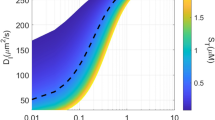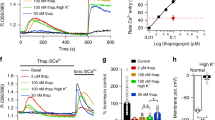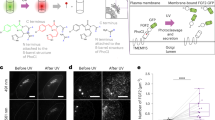Abstract
Inositol 1,4,5-trisphosphate (InsP3) releases calcium from intracellular stores and triggers complex waves and oscillations in levels of cytosolic free calcium1,2,3,4,5,. To determine which longer-term responses are controlled by oscillations in InsP3 and cytosolic free calcium, it would be useful to deliver exogenous InsP3, under spatial and temporal control, into populations of unpermeabilized cells. Here we report the 15-step synthesis of a membrane-permeant, caged InsP3 derivative from myo-inositol. This derivative diffused into intact cells and was hydrolysed to produce a caged, metabolically stable InsP3 derivative. This latter derivative accumulated in the cytosol at concentrations of hundreds of micromolar, without activating the InsP3 receptor. Ultraviolet illumination uncaged an InsP3 analogue nearly as potent as real InsP3, and generated spikes of cytosolic free calcium, and stimulated gene expression via the nuclear factor of activated T cells6,7. The same total amount of InsP3 analogue elicited much more gene expression when released by repetitive flashes at 1-minute intervals than when released at 0.5- or ⩾2-minute intervals, as a single pulse, or as a slow sustained plateau. Thus, oscillations in cytosolic free calcium levels at roughly physiological rates maximize gene expression for a given amount of InsP3.
This is a preview of subscription content, access via your institution
Access options
Subscribe to this journal
Receive 51 print issues and online access
$199.00 per year
only $3.90 per issue
Buy this article
- Purchase on Springer Link
- Instant access to full article PDF
Prices may be subject to local taxes which are calculated during checkout





Similar content being viewed by others
References
Berridge, M. J. Inositol triphosphate and calcium signalling. Nature 361, 315–325 (1993).
Tsien, R. W. & Tsien, R. Y. Calcium channels, stores, and oscillations. Annu. Rev. Cell Biol. 6, 715–760 (1990).
Jacob. R. Calcium oscillations in electrically nonexcitable cells. Biochim. Biophys. Acta 1052, 427–438 (1900).
Fewtrell, C. Ca2+ oscillations in non-excitable cells. Annu. Rev. Physiol. 55, 427–454 (1993).
Potter, B. V. L. & Lampe, D. Chemistry of inositol lipid mediated cellular signaling. Angew. Chemie Int. Edn Engl. 34, 1933–1972 (1995).
Crabtree, G. R. & Clipstone, N. A. Signal transmission between the plasma membrane and nucleus of T lymphocytes. Annu. Rev. Biochem. 63, 1045–1083 (1994).
Hutchinson, L. E. & McCloskey, M. A. FcεRI-mediated induction of nuclear factor of activated T-cells. J. Biol. Chem. 270, 16333–16338 (1995).
Dolmetsch, R. E., Xu, K. & Lewis, R. S. Calcium oscillations increase the efficacy and specificity of gene expression. Nature 392, 933–936 (1998).
Hirata, M. et al. Stereospecific recognition of inositol 1,4,5-triphosphate analogs by the phosphatase, kinase, and binding proteins. J. Biol. Chem. 265, 8404–8407 (1990).
Hirata, M., Watanabe, Y., Yoshida, M., Koga, T. & Ozaki, S. Roles for hydroxyl groups of D-myo-inositol 1,4,5-triphosphate in the recognition by its receptor and metabolic enzymes. J. Biol. Chem. 268, 19260–19266 (1993).
Kozikowski, A. P., Ognyanov, V. I., Fauq, A. H., Nahorski, S. R. & Wilcox, R. A. Synthesis of 1D-3-deoxy-, 1D-2,3-dideoxy-, and 1D-2,3,6-trideoxy-myo-inositol 1,4,5-trisphosphate from quebrachitol, their binding affinities, and calcium release activity. J. Am. Chem. Soc. 115, 4429–4434 (1993).
Li, W.-h., Schultz, C., Llopis, J. & Tsien, R. Y. Membrane-permeant esters of inositol polyphosphates, chemical synthesis and biological applications. Tetrahedron 53, 12017–12040 (1997).
Adams, S. R. & Tsien, R. Y. Controlling cell chemistry with caged compounds. Annu. Rev. Physiol. 55, 755–784 (1993).
Walker, J. W., Feeney, J. & Trentham, D. R. Photolabile precursors of inositol phosphates. Preparation and properties of 1-(2-nitrophenyl)ethyl esters of myo-inositol 1,4,5-trisphosphate. Biochemistry 28, 3272–3280 (1989).
Kao, J. P. Y., Harootunian, A. T. & Tsien, R. Y. Photochemically generated cytosolic calcium pulses and their detection by fluo-3. J. Biol. Chem. 264, 8179–8184 (1989).
Zlokarnik, G. et al. Quantitation of transcription and clonal selection of single living cells with β-lactamase as reporter. Science 279, 84–88 (1998).
Kuchtey, J. & Fewtrell, C. Subcloning of RBL-2H3 mucosal mast cell line reduces Ca2+ response heterogeneity as the single-cell level. J. Cell. Physiol. 166, 643–652 (1996).
Smith, G. D., Lee, R. J., Oliver, J. M. & Keizer, J. Effect of Ca2+ influx on intracellular free Ca2+ responses in antigen-stimulated RBL-2H3 cells. Am. J. Physiol. 270, C939–C952 (1996).
Timmerman, L. A., Clipstone, N. A., Ho, S. N., Northrop, J. P. & Crabtree, G. R. Rapid shuttling of NF-AT in discrimination of Ca2+ signals and immunosuppression. Nature 383, 837–840 (1996).
Dolmetsch, R. E., Lewis, R. S., Goodnow, C. G. & Healy, J. I. Differential activation of transcription factors induced by Ca2+ response amplitude and duration. Nature 386, 855–858 (1997).
Hajnóczky, G. & Thomas, A. P. The inositol trisphosphate calcium channel is inactivated by inositol trisphosphate. Nature 370, 474–477 (1994).
Oancea, E. & Meyer, T. Reversible desensitization of inositol trisphosphate-induced calcium release provides a mechanism for repetitive calcium spikes. J. Biol. Chem. 271 17253–17260 (1996).
Gu, X. & Spitzer, N. C. Distinct aspects of neuronal differentiation encoded by frequency of spontaneous Ca2+ transients. Nature 375, 784–787 (1995).
Hatchard, C. G. & Parker, C. A. Anew sensitive chemical actinometer. II. Potassium ferrioxalate as a standard chemical actinometer. Proc. R. Soc. Lond. A 235, 518–536 (1956).
Fiering, S. et al. Single cell assay of a transcription factor reveals a threshold in transcription activated by signals emanating from the T-cell antigen receptor. Genes Dev. 4, 1823–1834 (1990).
Vacca, J. P. et al. The total synthesis of myo-inositol polyphosphates. Tetrahedron 45, 5679–5702 (1989).
Acknowledgements
We thank E. A. Dennis for loan of facilities and S. R. Adams, A. Miyawaki, T. J. Rink and P. A. Negulescu for advice. This work was funded by the NIH and HHMI.
Author information
Authors and Affiliations
Rights and permissions
About this article
Cite this article
Li, Wh., Llopis, J., Whitney, M. et al. Cell-permeant caged InsP3 ester shows that Ca2+ spike frequency can optimize gene expression. Nature 392, 936–941 (1998). https://doi.org/10.1038/31965
Received:
Accepted:
Issue Date:
DOI: https://doi.org/10.1038/31965
This article is cited by
-
Structural titration reveals Ca2+-dependent conformational landscape of the IP3 receptor
Nature Communications (2023)
-
Calcium Dynamics and Water Transport in Salivary Acinar Cells
Bulletin of Mathematical Biology (2021)
-
Calcium signaling: breast cancer’s approach to manipulation of cellular circuitry
Biophysical Reviews (2020)
-
CalQuo 2 : Automated Fourier-space, population-level quantification of global intracellular calcium responses
Scientific Reports (2017)
-
Type 3 inositol 1,4,5-trisphosphate receptor is dispensable for sensory activation of the mammalian vomeronasal organ
Scientific Reports (2017)
Comments
By submitting a comment you agree to abide by our Terms and Community Guidelines. If you find something abusive or that does not comply with our terms or guidelines please flag it as inappropriate.



